Preparation and Physicochemical Properties of Blend Films of Feather Keratin and Poly(vinyl alcohol) Compatibilized by Tris(hydroxymethyl)aminomethane
Abstract
:1. Introduction
2. Materials and Methods
2.1. Materials
2.2. Extraction of Feather Keratin (FK)
2.3. Preparation of the FK/PVA/Tris Films
2.4. Preparation of the Control Films
2.5. Characterization
3. Results and Discussion
3.1. Morphology of the Films
3.2. FTIR Analysis
3.3. XRD Analysis
3.4. Mechanical Properties
3.5. Moisture Sensitivity of the Blend Films
3.6. Barrier Properties of the Prepared Films
3.6.1. Water Vapor Permeability (WVP)
3.6.2. Oxygen Permeability (OP)
4. Conclusions
5. Patents
Author Contributions
Funding
Acknowledgments
Conflicts of Interest
References
- Dou, Y.; Zhang, B.; He, M.; Yin, G.; Cui, Y. The structure, tensile properties and water resistance of hydrolyzed feather keratin-based bioplastics. Chin. J. Chem. Eng. 2016, 24, 415–420. [Google Scholar] [CrossRef]
- Pereira, V.A., Jr.; de Arruda, I.N.Q.; Stefani, R. Active chitosan/PVA films with anthocyanins from Brassica oleraceae (Red Cabbage) as Time–Temperature Indicators for application in intelligent food packaging. Food Hydrocolloids 2015, 43, 180–188. [Google Scholar] [CrossRef]
- Liu, B.; Xu, H.; Zhao, H.; Liu, W.; Zhao, L.; Li, Y. Preparation and characterization of intelligent starch/PVA films for simultaneous colorimetric indication and antimicrobial activity for food packaging applications. Carbohydr. Polym. 2017, 157, 842–849. [Google Scholar] [CrossRef] [PubMed]
- Cano, A.; Cháfer, M.; Chiralt, A.; González-Martínez, C. Development and characterization of active films based on starch-PVA, containing silver nanoparticles. Food Packaging Shelf 2016, 10, 16–24. [Google Scholar] [CrossRef] [Green Version]
- Chan, M.Y.; Husseinsyah, S.; Ting, S.S. A comparative study of different crosslinking agent-modified chitosan/corn cob biocomposite films. Polym. Bull. 2015, 72, 791–808. [Google Scholar]
- Avena-Bustillos, R.J.; Krochta, J.M. Water Vapor Permeability of Caseinate-Based Edible Films as Affected by pH, Calcium Crosslinking and Lipid Content. J. Food Sci. 2010, 58, 904–907. [Google Scholar] [CrossRef]
- Jin, E.; Reddy, N.; Zhu, Z.; Yang, Y. Graft polymerization of native chicken feathers for thermoplastic applications. J. Agric. Food Chem. 2011, 59, 1729–1738. [Google Scholar] [CrossRef] [PubMed]
- Zhao, L.; Zhou, H.; Hua, J. New Progress in Utilization of Feather Fibers. China Leather 2011, 40, 36–40. [Google Scholar]
- Batista, K.A.; Lopes, F.M.; Yamashita, F.; Fernandes, K.F. Lipase entrapment in PVA/Chitosan biodegradable film for reactor coatings. Mater. Sci. Eng. C Mater. Biol. Appl. 2013, 33, 1696–1701. [Google Scholar] [CrossRef] [PubMed]
- Tripathi, S.; Mehrotra, G.K.; Dutta, P.K. Physicochemical and bioactivity of cross-linked chitosan–PVA film for food packaging applications. Int. J. Biol. Macromol. 2009, 45, 372–376. [Google Scholar] [CrossRef] [PubMed]
- Vimala, K.; Yallapu, M.M.; Varaprasad, K.; Reddy, N.N.; Ravindra, S.; Naidu, N.S.; Raju, K.M. Fabrication of Curcumin Encapsulated Chitosan-PVA Silver Nanocomposite Films for Improved Antimicrobial Activity. J. Biomater. Nanobiotechnol. 2011, 2, 55–64. [Google Scholar] [CrossRef]
- Priya, B.; Gupta, V.K.; Pathania, D.; Singha, A.S. Synthesis, characterization and antibacterial activity of biodegradable starch/PVA composite films reinforced with cellulosic fibre. Carbohydr. Polym. 2014, 109, 171–179. [Google Scholar] [CrossRef] [PubMed]
- Panaitescu, D.M.; Frone, A.N.; Ghiurea, M.; Chiulan, I. Influence of storage conditions on starch/PVA films containing cellulose nanofibers. Ind. Crops Prod. 2015, 70, 170–177. [Google Scholar] [CrossRef]
- Noshirvani, N.; Ghanbarzadeh, B.; Fasihi, H.; Almasi, H. Starch-PVA Nanocomposite Film Incorporated with Cellulose Nanocrystals and MMT: A Comparative Study. Int. J. Food Eng. 2016, 12, 37–48. [Google Scholar] [CrossRef]
- Su, J.F.; Huang, Z.; Liu, K.; Fu, L.L.; Liu, H.R. Mechanical Properties, Biodegradation and Water Vapor Permeability of Blend Films of Soy Protein Isolate and Poly (vinyl alcohol) Compatibilized by Glycerol. Polym. Bull. 2007, 58, 913–921. [Google Scholar] [CrossRef]
- Su, J.F.; Huang, Z.; Zhao, Y.H.; Yuan, X.Y.; Wang, X.Y.; Li, M. Moisture sorption and water vapor permeability of soy protein isolate/poly(vinyl alcohol)/glycerol blend films. Ind. Crops Prod. 2010, 31, 266–276. [Google Scholar] [CrossRef]
- Wang, X.; Yucel, T.; Lu, Q.; Hu, X.; Kaplan, D.L. Silk nanospheres and microspheres from silk/pva blend films for drug delivery. Biomaterials 2010, 31, 1025–1035. [Google Scholar] [CrossRef] [PubMed] [Green Version]
- Dou, Y.; Zhang, B.N.; He, M.; Yin, G.Q.; Cui, Y.D. Preparation and Physicochemical Properties of Dialdehyde Starch Crosslinked Feather Keratin/PVA Composite Films. J. Macromol. Sci. Part A Pure Appl. Chem. 2014, 51, 1009–1015. [Google Scholar] [CrossRef]
- Dou, Y.; Zhang, B.; He, M.; Yin, G.; Cui, Y.; Savina, I.N. Keratin/Polyvinyl Alcohol Blend Films Cross-Linked by Dialdehyde Starch and Their Potential Application for Drug Release. Polymers 2015, 7, 580–591. [Google Scholar] [CrossRef] [Green Version]
- He, M.; Zhang, B.; Dou, Y.; Yin, G.; Cui, Y.; Chen, X. Fabrication and characterization of electrospun feather keratin/poly(vinyl alcohol) composite nanofibers. RSC Adv. 2017, 7, 9854–9861. [Google Scholar] [CrossRef] [Green Version]
- He, M.; Zhang, B.; Dou, Y.; Yin, G.; Cui, Y. Blend modification of feather keratin-based films using sodium alginate. J. Appl. Polym. Sci. 2017, 134, 44680–44687. [Google Scholar] [CrossRef]
- Zhang, Z.L. Research on the Process and Mechanism of Dissolving Keratin by Ionic Liquid. Master’s Thesis, University of Chinese Academy of Sciences, Beijing, China, 2017. [Google Scholar]
- Li, S. Fabrication and Characterization of Electrospun Wool Keratin/Poly(Vinyl Alcohol) Nanofibers Membrane. Ph.D. Thesis, Suzhou University, Suzhou, China, 2014. [Google Scholar]
- Grazziotin, A.; Pimentel, F.A.; de Jong, E.V.; Brandelli, A. Nutritional improvement of feather protein by treatment with microbial keratinase. Anim. Feed Sci. Technol. 2006, 126, 135–144. [Google Scholar] [CrossRef]
- Wu, X.; Liu, Y.; Liu, A.; Wang, W. Improved thermal-stability and mechanical properties of type I collagen by crosslinking with casein, keratin and soy protein isolate using transglutaminase. Int. J. Biol. Macromol. 2017, 98, 292–301. [Google Scholar] [CrossRef] [PubMed]
- Wang, K.; Luo, S.; Cai, J.; Sun, Q.; Zhao, Y.; Zhong, X.; Jiang, S.; Zheng, Z. Effects of partial hydrolysis and subsequent cross-linking on wheat gluten physicochemical properties and structure. Food Chem. 2016, 197, 168–174. [Google Scholar] [CrossRef] [PubMed]
- Wu, X.; Liu, A.; Wang, W.; Ye, R. Improved mechanical properties and thermal-stability of collagen fiber based film by crosslinking with casein, keratin or SPI: Effect of crosslinking process and concentrations of proteins. Int. J. Biol. Macromol. 2018, 109, 1319–1328. [Google Scholar] [CrossRef] [PubMed]
- Sengwa, R.J.; Choudhary, S. Structural characterization of hydrophilic polymer blends/montmorillonite clay nanocomposites. J. Appl. Polym. Sci. 2014, 131, 354–364. [Google Scholar] [CrossRef]
- Rao, J.K.; Raizada, A.; Ganguly, D.; Mankad, M.M.; Satayanarayana, S.V.; Madhu, G.M. Investigation of structural and electrical properties of novel CuO–PVA nanocomposite films. J. Mater. Sci. 2015, 50, 7064–7074. [Google Scholar] [CrossRef]
- Yue, Q.Q. Application Status and Development Trend of Barrier Packaging Materials. Plast. Packag. 2011, 21, 19–21. [Google Scholar]
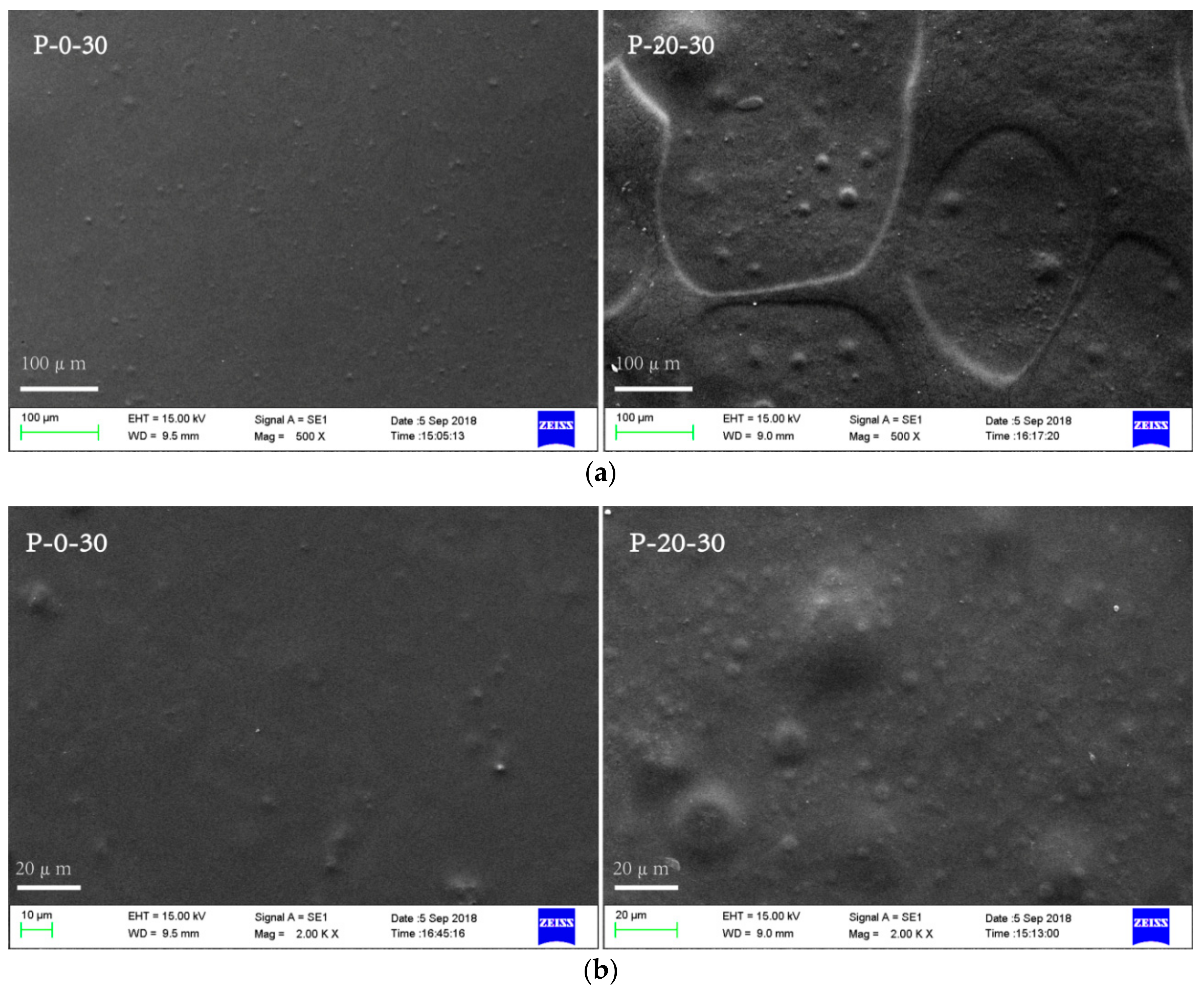
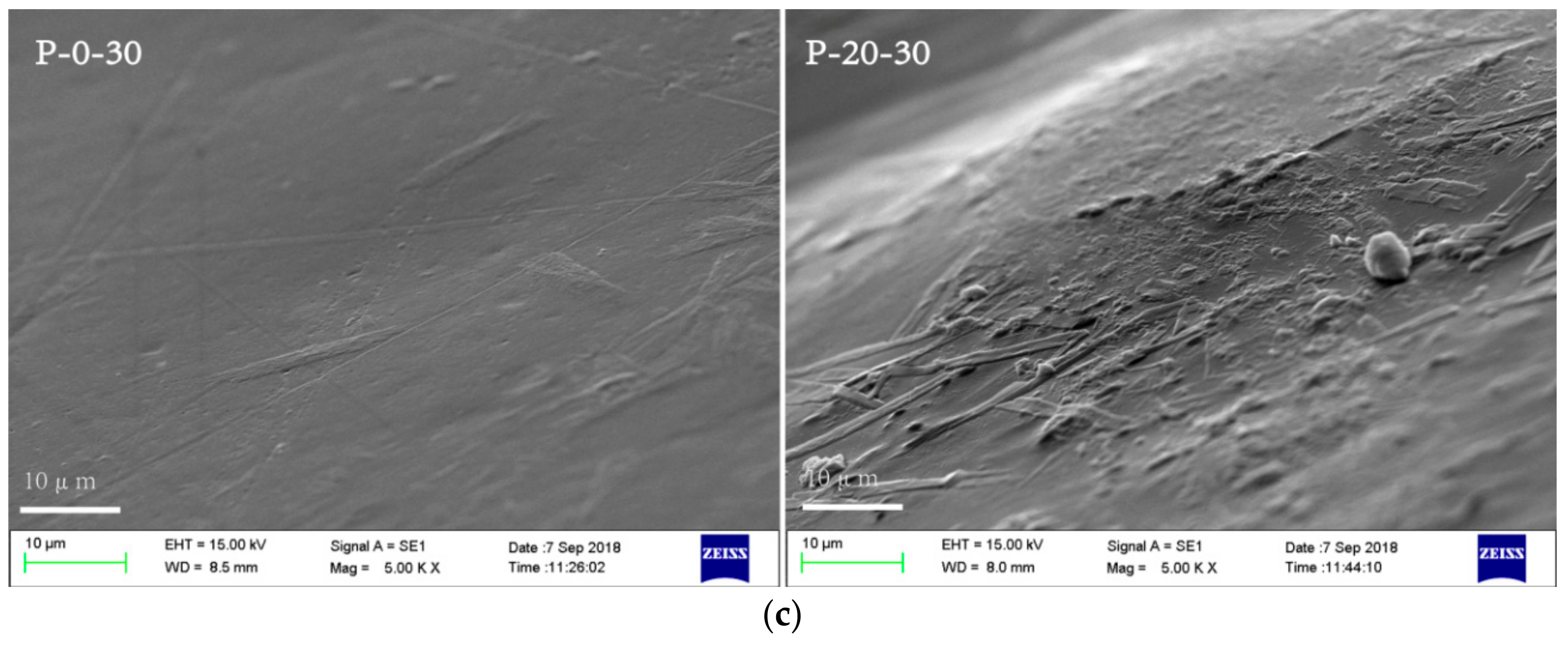
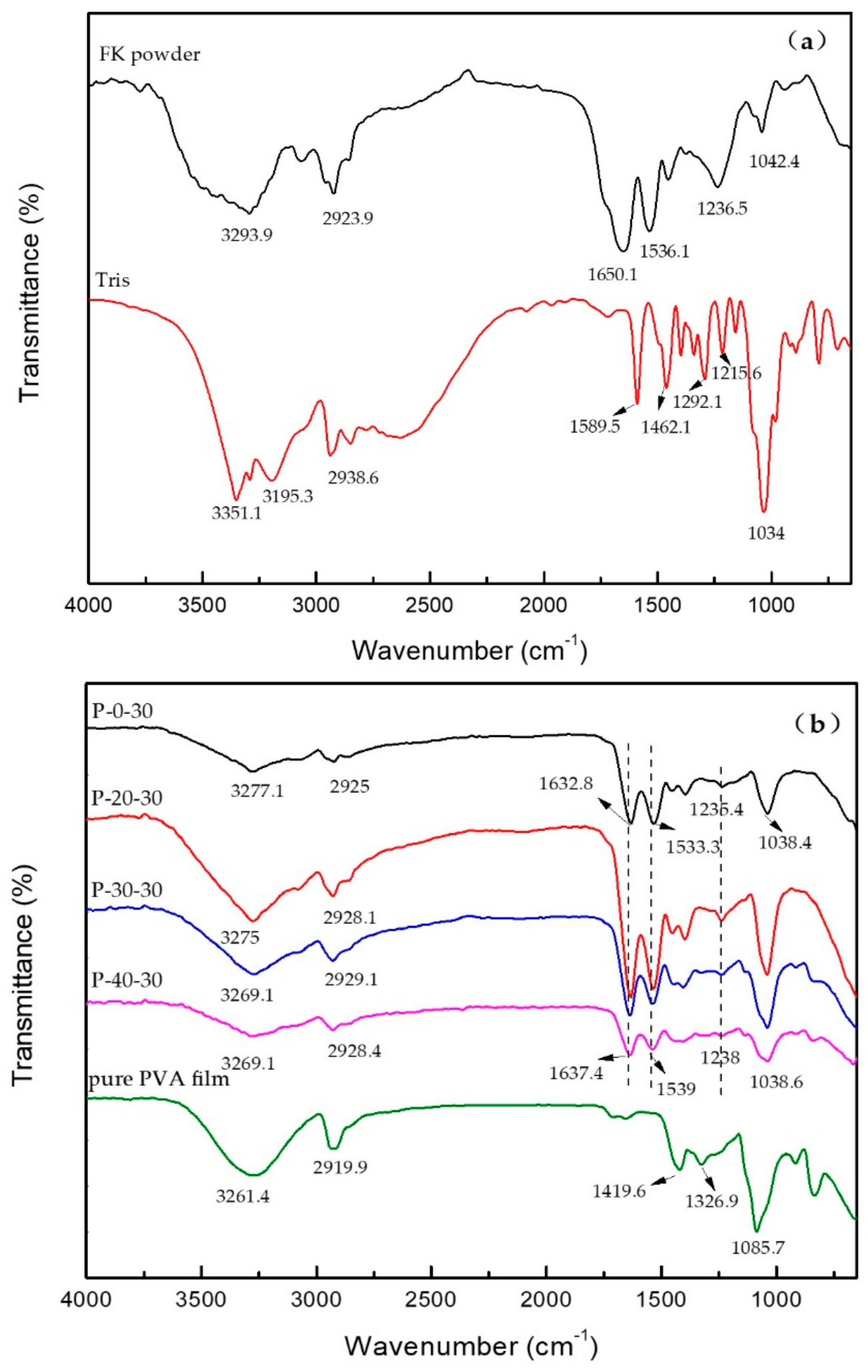
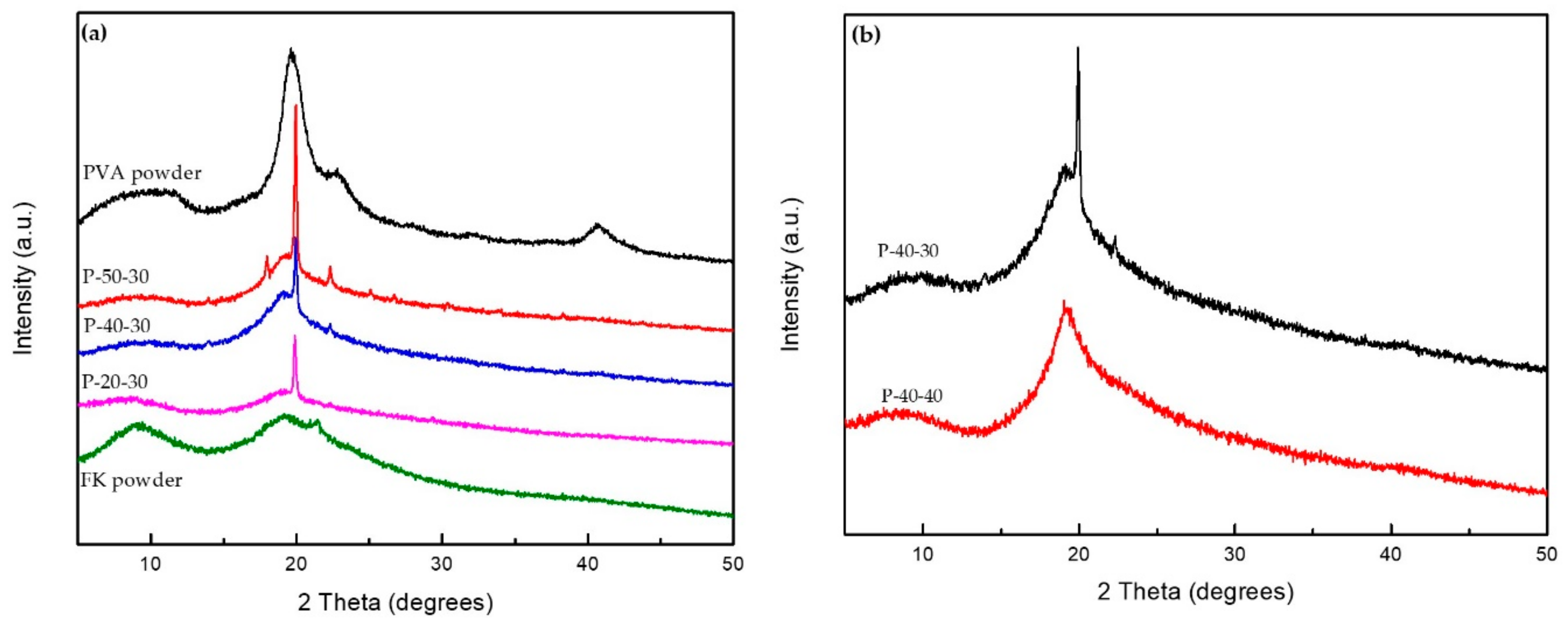
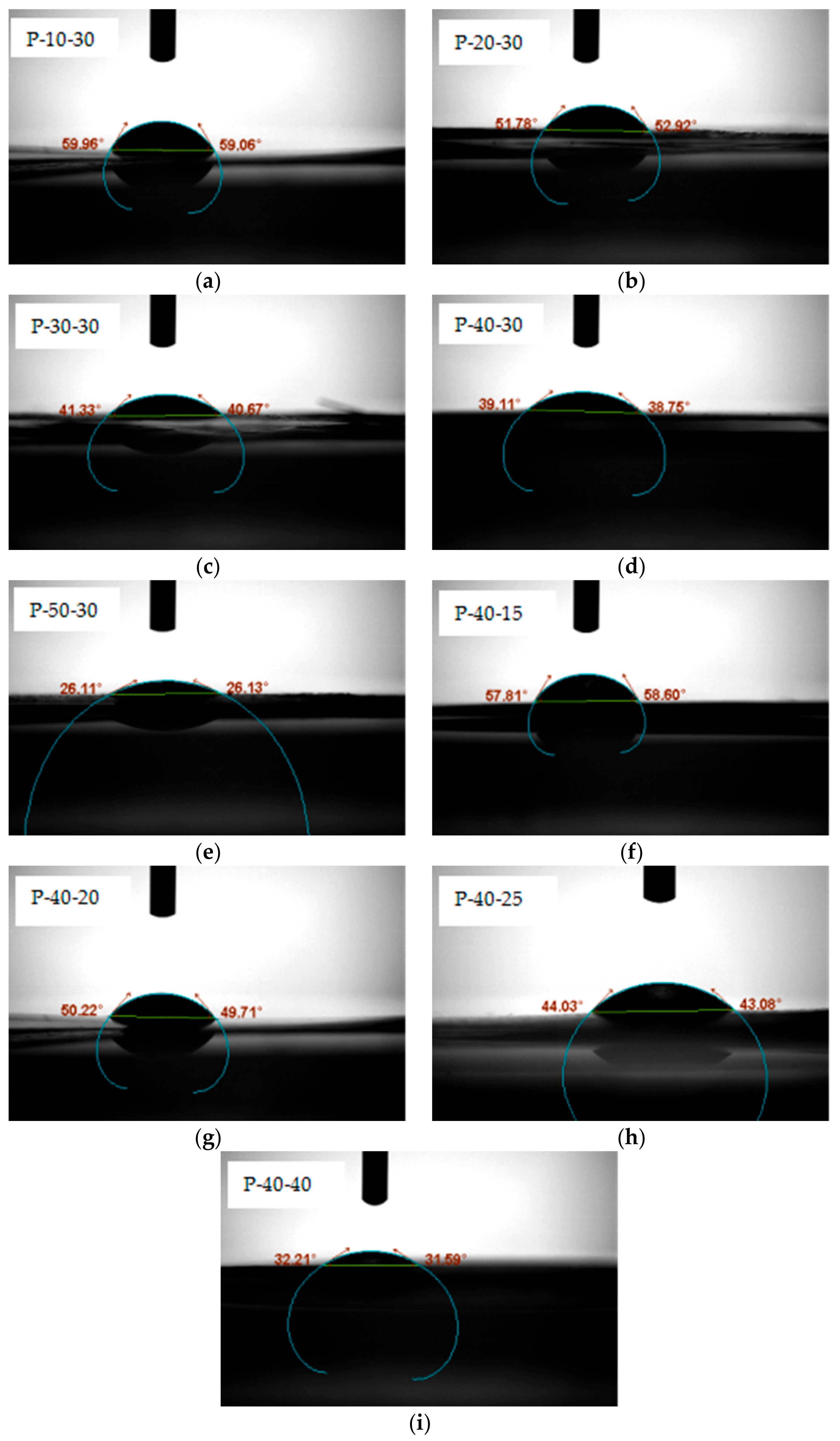
| Sample | α-Helix (%) | β-Turn (%) | β-Sheet (%) | Random Coil (%) |
|---|---|---|---|---|
| P-0-30 | 13.98 | 24.3 | 39.55 | 19.89 |
| P-10-30 | 13.8 | 23.87 | 40.43 | 19.89 |
| P-20-30 | 14.1 | 23.63 | 39.77 | 20.3 |
| P-30-30 | 14.89 | 26.36 | 36.53 | 20.49 |
| P-40-30 | 14.78 | 26.8 | 36.14 | 20.65 |
| P-50-30 | 15.66 | 26.29 | 35.62 | 21.51 |
| Sample | Elastic Modulus (MPa) | Elongation at Break (%) | Tensile Strength (MPa) | Thickness (mm) |
|---|---|---|---|---|
| P-10-30 | 493.66 ± 21.98 | 1.75 ± 0.35 | 7.03 ± 0.68 | 0.1 ± 0.005 |
| P-20-30 | 324.41 ± 16.75 | 2 ± 0 | 5.07 ± 0.1 | 0.117 ± 0.004 |
| P-30-30 | 327.97 ± 38.95 | 7 ± 0.71 | 8.98 ± 0.07 | 0.094 ± 0.002 |
| P-40-30 | 311.33 ± 25.05 | 23.67 ± 3.53 | 8.12 ± 0.59 | 0.081 ± 0.003 |
| P-50-30 | 214.55 ± 16.13 | 179.83 ± 9.11 | 9.52 ± 1.07 | 0.08 ± 0.004 |
| P-40-15 | 2007.31 ± 38.76 | 1.5 ± 0 | 22.89 ± 0.22 | 0.067 ± 0.002 |
| P-40-20 | 742.74 ± 45.86 | 2.67 ± 0.16 | 12.2 ± 0.87 | 0.076 ± 0.008 |
| P-40-25 | 416.78 ± 17.34 | 10.83 ± 1.01 | 9.58 ± 0.37 | 0.087 ± 0.004 |
| P-40-30 | 311.33 ± 25.05 | 23.67 ± 3.53 | 8.12 ± 0.59 | 0.081 ± 0.004 |
| P-40-40 | 422.16 ± 45.12 | 16.67 ± 0.91 | 5.92 ± 0.2 | 0.103 ± 0.003 |
| G-40-0 | 1257.18 ± 28.58 | 1.5 ± 0 | 8.95 ± 0.01 | 0.081 ± 0 |
| G-40-15 | 15.81 ± 5.19 | 262 ± 0.71 | 3.87 ± 0.27 | 0.081 ± 0.006 |
| Sample | WVP (×10−12 g·cm−1·s−1·Pa−1) | OP (×10−5 cm3·m−2·d−1·Pa−1) |
|---|---|---|
| P-10-30 | – | – |
| P-20-30 | 2.74 ± 0.16 | – |
| P-30-30 | 3 ± 0.26 | – |
| P-40-30 | 3.36 ± 0.18 | 7.907 ± 0.35 |
| P-50-30 | 3.68 ± 0.1 | 3.214 ± 0.26 |
| P-40-15 | 1.47 ± 0.08 | 5786 ± 6.7 |
| P-40-20 | 1.87 ± 0.11 | 28.72 ± 1.2 |
| P-40-25 | 3.09 ± 0.1 | 11.78 ± 0.65 |
| P-40-30 | 3.36 ± 0.18 | 7.907 ± 0.35 |
| P-40-40 | 2.66 ± 0.09 | 13.78 ± 1.08 |
| G-40-0 | 1.7 ± 0.05 | – |
| G-40-15 | 3.43 ± 0.14 | – |
© 2018 by the authors. Licensee MDPI, Basel, Switzerland. This article is an open access article distributed under the terms and conditions of the Creative Commons Attribution (CC BY) license (http://creativecommons.org/licenses/by/4.0/).
Share and Cite
Chen, X.; Wu, S.; Yi, M.; Ge, J.; Yin, G.; Li, X. Preparation and Physicochemical Properties of Blend Films of Feather Keratin and Poly(vinyl alcohol) Compatibilized by Tris(hydroxymethyl)aminomethane. Polymers 2018, 10, 1054. https://doi.org/10.3390/polym10101054
Chen X, Wu S, Yi M, Ge J, Yin G, Li X. Preparation and Physicochemical Properties of Blend Films of Feather Keratin and Poly(vinyl alcohol) Compatibilized by Tris(hydroxymethyl)aminomethane. Polymers. 2018; 10(10):1054. https://doi.org/10.3390/polym10101054
Chicago/Turabian StyleChen, Xunjun, Shufang Wu, Minghao Yi, Jianfang Ge, Guoqiang Yin, and Xinming Li. 2018. "Preparation and Physicochemical Properties of Blend Films of Feather Keratin and Poly(vinyl alcohol) Compatibilized by Tris(hydroxymethyl)aminomethane" Polymers 10, no. 10: 1054. https://doi.org/10.3390/polym10101054






